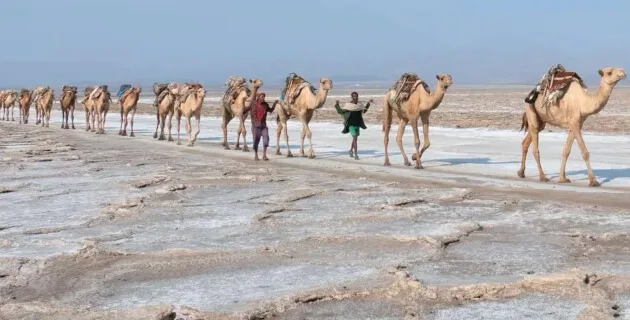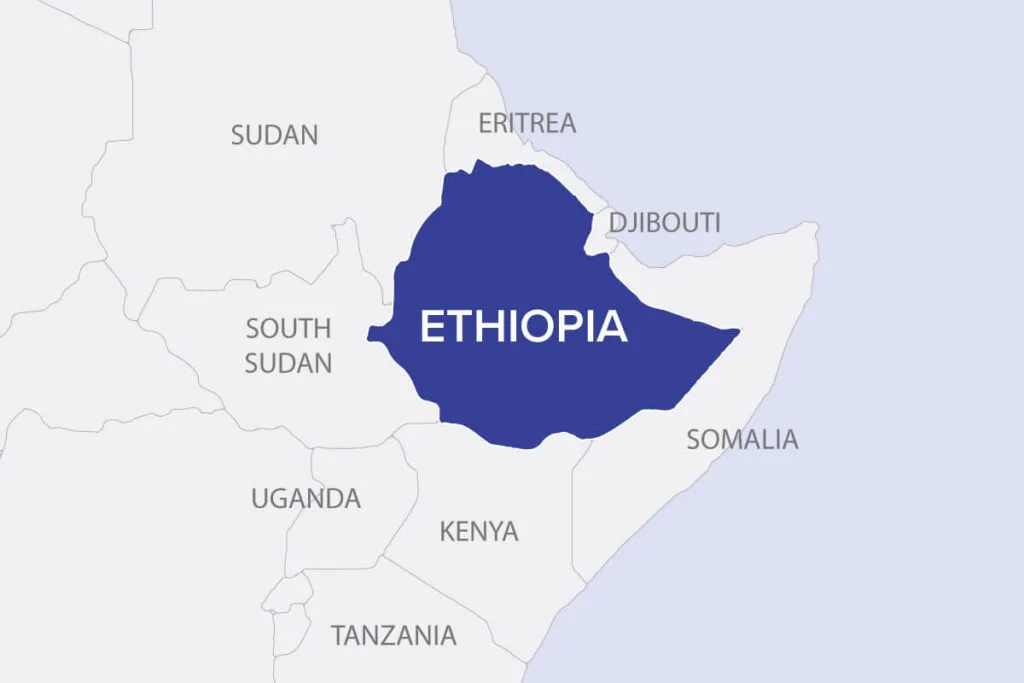About Ethiopia
About Ethiopia is your resource for all things Ethiopia. Discover about Ethiopian people, culture, facts, languages, calendar, flag and more. Find out the best places to visit, from historical sites to natural wonders. Discover the delicious flavours of Ethiopian cuisine and the country’s vibrant music.
Overview About Ethiopia
Ethiopia is a country located in the Horn of Africa that boasts a rich blend of ancient history, diverse cultures, and breathtaking landscapes. Known as the cradle of civilization, Ethiopia is a land where history comes alive, with archaeological treasures that reveal the story of humanity’s earliest ancestors. Our website is your gateway to discovering the many unique aspects of Ethiopia, a nation of many natural wonders. We offer an in-depth look at what makes Ethiopia truly exceptional, from its distinctive calendar system, which is seven to eight years behind the Gregorian calendar with 13 months, to the diversity of its people and languages. Ethiopia is a country where more than 80 languages are spoken, reflecting a vibrant and complex cultural mosaic that we explore in detail.

Ethiopia Country Profile
Delve into Ethiopia’s fascinating ancient civilizations and how they have shaped the country’s modern identity. Our website covers the uniqueness of Ethiopian cuisine, a blend of flavors and traditions that are as diverse as its people. We also provide insights into the breathtaking landscapes, from the towering Simien Mountains to the dramatic Great Rift Valley, showing how Ethiopia’s topography contributes to its distinct character.
Explore the rich culture of Ethiopia, where traditions are deeply rooted in its history and expressed in everything from festivals to everyday life. Our site is filled with information on Ethiopia’s varied and dynamic regions, offering a comprehensive view of what makes this nation unlike any other.
Whether it’s the people, the places, the history, or the cultural practices, our website is your go-to resource for understanding all the elements that make Ethiopia a truly unique country. Explore our Ethiopia country profile to dive deeper into the nation’s rich heritage, diverse landscapes, and vibrant traditions.
Where is Ethiopia Located
Ethiopia is located in the Horn of Africa, a strategically significant region in East Africa. It is a landlocked country bordered by Eritrea to the north, Djibouti and Somalia to the east, Kenya to the south, and Sudan and South Sudan to the west.

Ethiopia’s central position in this part of the continent makes it a crossroads of cultures and civilizations, with a diverse landscape that includes everything from the towering Simien Mountains to the arid expanses of the Ogaden Desert. The country’s geographical location has played a crucial role in its historical development, serving as a bridge between Africa, the Middle East, and beyond.
Ethiopian People
Learning about the Ethiopian people is an essential part of discovering Ethiopia. They represent a remarkable blend of diverse ethnicities, each contributing to the rich cultural fabric that defines the nation. With over 80 distinct ethnic groups, Ethiopia is a land where a variety of languages, customs, and traditions coexist harmoniously, creating a vibrant and dynamic society.
Ethiopia’s largest ethnic groups, include the Oromo, Amhara, Somali, and Tigray. Each group has its own language and unique cultural practices that have been passed down through generations. This incredible diversity is beautifully reflected in the country’s music, dance, and art, which vary significantly from one region to another.
Understanding the Ethiopian people also means appreciating a society deeply rooted in communal life, where traditional values and hospitality are central to daily life. One of the most iconic cultural expressions you’ll learn is the traditional Ethiopian coffee ceremony —a symbolic act of friendship and respect that highlights the warmth and generosity of its people.
The resilience of the Ethiopian people is equally noteworthy. Despite facing centuries of external challenges, they have steadfastly maintained their cultural identity and independence, making Ethiopia a truly unique and inspiring nation. As you explore our site, you’ll find a wealth of information that delves deeper into the lives, traditions, and customs of the Ethiopian people, offering a comprehensive understanding of this extraordinary country.
Languages of Ethiopia
Ethiopia is one of the most multilingual countries in the world, with over 80 distinct ethnic groups, each speaking its own language. Amharic, the official working language of the Ethiopian government, is widely spoken and uses the ancient Ge’ez script, contributing to its historical significance. Oromo, another major language, is spoken predominantly in the Oromia region and uses the Latin alphabet, while Tigrinya, closely related to Ge’ez, is spoken in the Tigray region. Sidamo, Somali, Afar, Hadiyya, Gamo, and Wolaitta are other important languages, each reflecting the diverse cultural and linguistic heritage of their respective regions.
Exploring Ethiopian languages offers valuable insights into the country’s diverse ethnic groups and rich cultural heritage. Each language not only serves as a means of communication but also as a vessel for traditions, history, and identity, making Ethiopia’s linguistic landscape as fascinating and complex as its cultural and geographical diversity.
The Capital of Ethiopia
Addis Ababa, the vibrant capital of Ethiopia, is a city of contrasts where tradition meets modernity. Established in 1886 by Emperor Menelik II, Addis Ababa—meaning “New Flower” in Amharic—has grown into a bustling metropolis that serves as the political, economic, and cultural hub of the nation. It is home to the African Union’s headquarters and numerous international organizations, earning it the nickname “the political capital of Africa.”
The city holds significant historical and cultural value, with landmarks such as the Holy Trinity Cathedral, the National Museum of Ethiopia, and the Ethnological Museum offering deep insights into Ethiopia’s past. Addis Ababa is also famous for its vibrant markets, including the sprawling Mercato, one of Africa’s largest open-air markets, where you can find everything from traditional crafts to spices and textiles.
As the gateway to the rest of Ethiopia, Addis Ababa is often the starting point for visitors eager to explore the country’s rich heritage and diverse landscapes. Understanding Addis Ababa is essential for anyone wanting to know Ethiopia’s cultural makeup, as the city perfectly encapsulates the dynamic spirit of the nation.
Ethiopian Cities
Exploring Ethiopian cities provides a fascinating glimpse into the riches of Ethiopia’s history, culture, and modern life. Each city offers a unique perspective on the nation’s diverse heritage and contemporary developments.
Gondar, often called the “Camelot of Africa,” is known for its medieval castles and the UNESCO-listed Royal Enclosure, along with the stunning Debre Berhan Selassie Church. Lalibela, with its rock-hewn churches, is one of Ethiopia’s holiest cities and a UNESCO World Heritage site, showcasing remarkable spiritual and architectural significance. Bahir Dar, situated on Lake Tana, is celebrated for its natural beauty, the Blue Nile Falls, and ancient monasteries. Axum, famed for its towering obelisks and ties to the Ark of the Covenant, offers deep historical insights. Harar, the “City of Saints,” is a walled city with a rich cultural and religious heritage, featuring over 80 mosques and vibrant markets. Dire Dawa serves as a key commercial hub and transport link, highlighting Ethiopia’s diverse population. Mekelle, the capital of Tigray, is known for its historical significance and as a gateway to the region’s rock churches, as well as its role in education and research.
Each of these cities contributes to the rich mosaic of Ethiopian life, offering a blend of history, culture, and modernity that reflects the nation’s remarkable diversity and dynamism.
The History of Ethiopia
The history of Ethiopia is among the most ancient and continuous in the world, offering a fascinating journey through millennia. Ethiopia is home to the ancient Kingdom of Aksum, one of the greatest empires of the ancient world, renowned for its monumental obelisks and as an early center of Christianity. The Aksumite Empire was a major trading power, linking the Roman Empire and India through its strategic Red Sea ports.
Delving deeper into the history of Ethiopia, you’ll encounter the medieval Zagwe Dynasty, celebrated for its remarkable rock-hewn churches in Lalibela. These churches, carved directly into the rock, are a testament to Ethiopia’s architectural and spiritual heritage. The subsequent Solomonic Dynasty, which claimed descent from the biblical King Solomon and the Queen of Sheba, ruled Ethiopia for centuries, with Emperor Haile Selassie being its last reigning monarch.
Ethiopia was successful in having a resistance against colonization. The Battle of Adwa in 1896 stands out as a pivotal moment when Ethiopian forces defeated the Italian army, securing the country’s independence and becoming a symbol of resistance against imperialism.
Ethiopia’s rich and diverse historical narrative is a source of immense pride for its people and continues to be a crucial element of national identity. As you explore Ethiopia, you’ll uncover a history that is not only ancient but also remarkably resilient and influential.
Ethiopia Religions
Religion is deeply woven into the fabric of Ethiopian society, reflecting a history that spans millennia. Ethiopian Orthodox Christianity, one of the oldest Christian traditions in the world, dates back to the 4th century when King Ezana of Aksum adopted Christianity as the state religion. The Ethiopian Orthodox Church remains central to the country’s identity, celebrated for its unique traditions, ancient monasteries, and sacred sites, such as the rock-hewn churches of Lalibela and the monasteries on Lake Tana.
As you explore Ethiopia further, you’ll also discover the significant presence of Islam in the country’s rich cultural makeup. The religion arrived in Ethiopia during the early days of Islam when followers of Prophet Muhammad sought refuge in the Aksumite Empire. Today, Ethiopia has a substantial Muslim population, particularly in the eastern regions, where cities like Harar are renowned as important centers of Islamic learning and culture.
In addition to Christianity and Islam, Ethiopia’s religious landscape includes a variety of indigenous beliefs, particularly among the smaller ethnic groups in the southern and western parts of the country. This diversity in religious practices has fostered a culture of coexistence and mutual respect, making Ethiopia a land of exceptional spiritual richness.
Understanding Ethiopia’s religious heritage offers a profound appreciation of the country’s ability to harmoniously integrate a wide array of spiritual traditions, reflecting its unique and inclusive approach to faith.
Ethiopia Regions
Exploring Ethiopia’s regions offers a captivating glimpse into the country’s rich variety of landscapes and cultures. Ethiopia’s regional diversity showcases a nation with distinct geographical and cultural characteristics, divided into 11 regional states, each offering its own unique features:
The Amhara Region, home to the ancient city of Gondar, the rock-hewn churches of Lalibela, the source of the Blue Nile, and the stunning Simien Mountains, is a key area for exploring Ethiopia’s historical and natural wonders. In the north, the Tigray Region is celebrated for its historical treasures, including the ancient city of Axum and the remarkable rock-hewn churches, set against rugged landscapes filled with ancient monasteries and archaeological sites.
The Oromia Region, Ethiopia’s largest, features diverse landscapes like the Bale Mountains and the coffee plantations of Jimma, with Addis Ababa, the nation’s capital, serving as a vibrant cultural and administrative hub. The Southern Nations, Nationalities, and Peoples’ Region (SNNPR) is known for its ethnic diversity and cultural richness, exemplified by the indigenous tribes of the Omo Valley and the fertile areas around Arba Minch and the Great Rift Valley lakes.
The Sidama Region, famous for its lush landscapes and high-quality coffee production, also showcases vibrant traditional cultures. In the southwest, the South West Ethiopia Peoples’ Region (SWEPR) offers a mix of ethnic diversity and natural beauty, with fertile highlands and forested areas highlighting the region’s agricultural significance.
Benishangul-Gumuz, located in western Ethiopia, is known for its rich natural resources, ethnic diversity, and varied landscapes, including parts of the Blue Nile River basin. Gambela, in the westernmost part of Ethiopia, features expansive lowlands and wetlands like the Gambela National Park, and is home to diverse ethnic groups and vibrant traditional practices. The Harari Region, though small, holds great historical significance with its walled city of Harar, one of Islam’s holiest cities, known for its ancient architecture and colorful markets.
Ethiopia’s regional diversity offers a comprehensive view of the country’s multifaceted identity, highlighting its varied landscapes and the vibrant cultures that characterize each region.
Important Facts About Ethiopia
Ethiopia is a country brimming with intriguing facts that underscore its uniqueness and significance on the global stage. Here are some of the top facts on Ethiopia that highlight its remarkable attributes:
- Oldest Independent Country in Africa: Ethiopia stands out as the only African nation never to have been colonized, maintaining its independence throughout the Scramble for Africa. The victory at the Battle of Adwa in 1896 is a proud moment in Ethiopian history, where Ethiopian forces successfully resisted Italian invasion and preserved the nation’s sovereignty.
- Cradle of Humanity: Ethiopia is renowned as the home of some of the world’s oldest human remains. The famous fossilized skeleton, “Lucy,” or “Dinknesh” as she is known in Ethiopia, was discovered in the Awash Valley. Estimated to be 3.2 million years old, Lucy provides invaluable insights into human evolution and Ethiopia’s role in our shared history.
- Ancient Civilization: The Aksumite Empire, thriving from approximately 100 AD to 940 AD, was one of the great civilizations of the ancient world. The city of Axum, located in the Tigray region, was a major trade center and is renowned for its towering obelisks, ancient tombs, and as the supposed resting place of the Ark of the Covenant.
- Unique Alphabet and Calendar: Ethiopia is distinguished by its use of the Ge’ez script, also known as Ethiopic, one of the few indigenous scripts still in use in Africa. The Ethiopian calendar is equally unique, being approximately seven to eight years behind the Gregorian calendar and comprising 13 months—12 months of 30 days each and one month of 5 or 6 days.
- Diverse Climate and Geography: Ethiopia’s geography offers a remarkable range of landscapes, from the Danakil Depression, one of the hottest and lowest places on Earth, to the highlands of the Simien Mountains, which include some of Africa’s highest peaks. This geographical diversity results in a variety of climates, from arid deserts to cool, fertile highlands, highlighting Ethiopia’s natural wonder.
- Coffee Origin: Ethiopia is celebrated as the birthplace of coffee. According to legend, a goat herder named Kaldi discovered coffee in the Kaffa region when he noticed his goats becoming unusually energetic after eating berries from a particular tree. Today, coffee remains a central element of Ethiopian culture and is one of the country’s most significant exports.
- One of the Oldest Christian Nations: Ethiopia was among the first countries to adopt Christianity as the state religion in the 4th century AD. The Ethiopian Orthodox Church is deeply rooted in the nation’s history and culture, with many ancient churches and monasteries still serving as places of worship today.
Discover more facts about Ethiopia that showcase the country’s rich historical legacy, cultural depth, and natural wonders, making it a compelling destination for anyone interested in exploring one of the world’s most unique nations.
Frequently asked questions about Ethiopia
What year is it in Ethiopia?
Ethiopia uses a unique calendar that is roughly seven to eight years behind the Gregorian calendar, so the current Ethiopian year is 2017.
What time is it in Ethiopia?
Ethiopia uses East Africa Time (EAT), which is UTC+3 hours. Time in Ethiopia is also often measured from dawn, so the traditional Ethiopian timekeeping might differ from the standard clock.
Where is Ethiopia located?
Ethiopia is located in the Horn of Africa, bordered by Eritrea, Djibouti, Somalia, Kenya, South Sudan, and Sudan.
What is the capital of Ethiopia?
The capital of Ethiopia is Addis Ababa.
What language do they speak in Ethiopia?
Amharic is the official language of Ethiopia, but there are over 80 languages spoken across the country.
What is Ethiopia famous for?
Ethiopia is famous for its ancient history, being the cradle of humanity, its unique calendar, and its role as the birthplace of coffee.
Is English spoken in Ethiopia?
Yes, English is widely spoken in Ethiopia, especially in education, government, and business.



